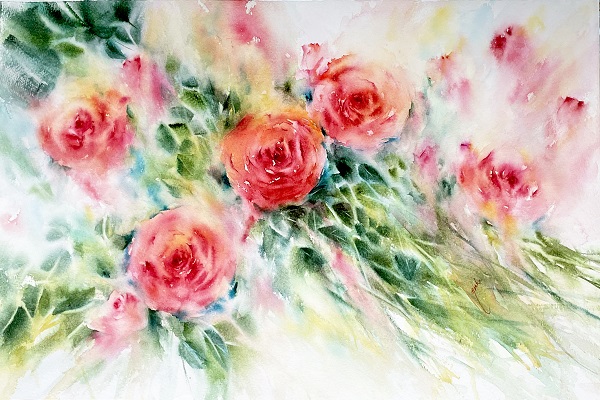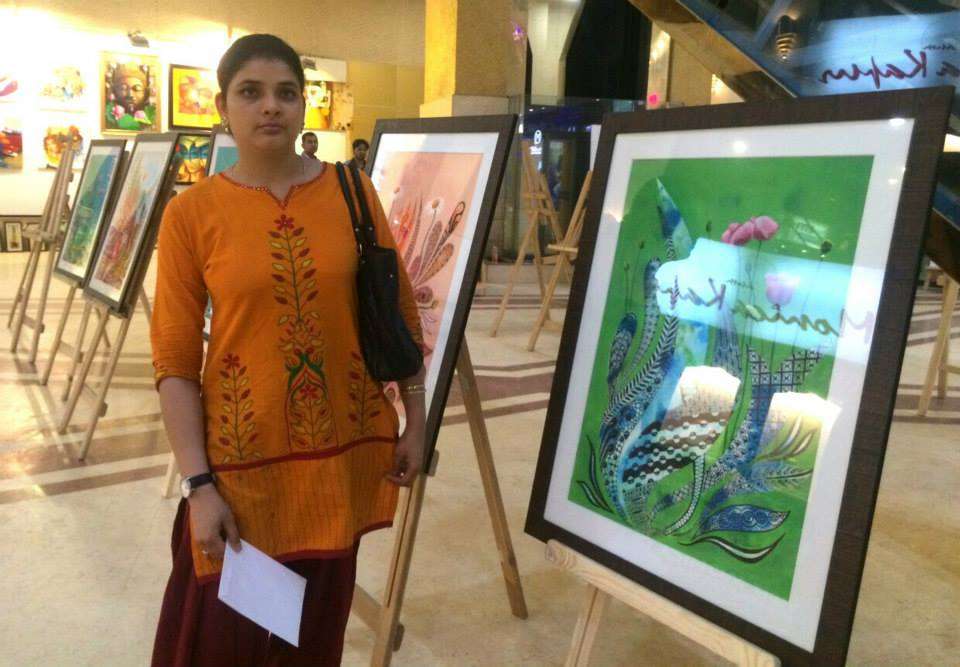
A painting is worth a thousand words. But what if we told you that every brushstroke, every layer of pigment, could hold the secrets to captivating art? Consider this: Art, much like life, thrives on depth and texture. Have you ever wondered how some paintings seem to leap off the canvas while others remain flat and lifeless? In watercolor and oil painting, there's a hidden world of techniques, a realm of secrets waiting to be unveiled.
In this blog, we'll unravel the enigmatic techniques artists use in watercolor and oil painting to achieve that elusive depth and texture. We'll delve into the unique methods and tools. Whether you're a seasoned artist or just starting your creative journey, the secrets we uncover here will leave you inspired and ready to infuse your artwork with new life and vitality.
Defining Depth and Texture in Paintings
Depth in painting is a concept that goes beyond mere three-dimensionality. It refers to the illusion of distance and dimension on a flat surface. Consider it a portal to the artist's envisioned world, a realm where the artist skillfully directs your gaze to unravel the intricate layers of the composition. With the masterful play of color, perspective, and shading, depth breathes life into a painting, drawing you further into the depicted scene and extending an enticing invitation to become a part of the frame.
Texture, conversely, is the tactile quality of a surface or the visual representation of tactile qualities. In the context of paintings, it's all about how the surface appears to feel. Artists achieve texture through various techniques, from brushwork and impasto (thick, textured paint applications) to delicate stippling and fine details. Texture adds richness to a painting, making it more than just an image; it's an experience, invoking a desire to reach out and touch.
The Crucial Role of Depth and Texture in Captivating Artworks
Now, why do these elements matter so much in the world of art?
1. Emotional Resonance
Depth and texture establish a profound emotional link between the artwork and its observer. The visual trickery of depth has the incredible power to immerse you within the scene, summoning forth a wave of emotions tied to the subject matter. Texture, whether smooth or rough, can elicit visceral reactions, from tranquility to excitement.
2. Visual Interest
Captivating paintings are dynamic and engaging. Depth and texture keep the eye moving across the canvas, exploring every nook and cranny. They prevent monotony, ensuring there's always something new to discover, a detail you hadn't noticed before.
3. Storytelling
In art, every brushstroke has a tale to tell. Depth and texture serve as storytellers, conveying the narrative, history, and mood of the subject. They are the artists' tools for adding meaning to their creations.
4. Realism and Expression
Whether striving for realism or expressing abstract concepts, depth, and texture are your allies. They provide the realism necessary to bring a scene to life or the visual language to convey abstract ideas.
Watercolor Techniques for Depth and Texture
Watercolor painting is often associated with its delicate and transparent nature, but did you know it can also offer remarkable depth and texture in your artwork? Let's explore the specific techniques that watercolor artists use to achieve just that, allowing their creations to leap off the paper in three-dimensional splendor.
Creating Depth with Watercolor
Watercolor painting, often known for its ethereal and transparent qualities, has a hidden power – the ability to convey depth and dimension. Let's uncover the secrets that watercolor artists use to make their paintings come alive with three-dimensional magic. From the subtle interplay of layered washes to the mesmerizing dance of wet-on-wet and wet-on-dry techniques, you'll discover how artists create artworks that draw you into their world. These methods are your passport to adding depth to your watercolor masterpieces, allowing you to transform flat paper into a portal to captivating dimensions.
1. Layering and Transparency
One of the most fundamental techniques for adding depth to watercolor paintings is through the art of layering. Artists build their compositions by applying multiple transparent washes of color. Every layer you apply introduces a fresh dimension to your painting, conjuring the enchanting illusion of depth. Beginning with the lightest washes and meticulously progressing to deeper tones, you can masterfully craft a convincing portrayal of distance and perspective, breathing life and vitality into your subjects.
Imagine a serene landscape with a distant mountain range. By layering varying shades of blue and gray in transparent washes, you can convey the depth and distance of the mountains, making them appear far-off and majestic.
2. Wet-on-Wet and Wet-on-Dry Methods
Watercolorists often employ two primary painting methods - wet-on-wet and wet-on-dry. Wet-on-wet involves applying paint to wet paper, creating soft and blended edges, ideal for smooth transitions and atmospheric effects. Conversely, wet-on-dry applies paint to dry paper, producing sharper edges and more controlled details. By skillfully combining these methods within a single artwork, artists can craft an intricate interplay of depth and texture.
Picture a floral arrangement with dew-kissed petals. The wet-on-wet technique can create the soft, ethereal quality of the petals. On the other hand, the wet-on-dry method brings out the intricate details of each bloom.
Adding Texture to Your Watercolor Masterpiece
Texture, in watercolor painting, is like a secret ingredient that can take your artwork from good to extraordinary. It adds tactile and visual interest, making your creations not only visually appealing but also intriguing to touch with the eyes. We're about to unveil two remarkable techniques: salt texture and masking fluid. The former introduces a grainy, almost celestial quality to your work, while the latter offers a fascinating juxtaposition of textures. These tools can help you transcend the two-dimensional nature of paper and create watercolor paintings that engage all the senses, making your art truly unforgettable.
1. Salt Texture
This fascinating technique involves sprinkling table salt onto your wet watercolor washes. As the paint dries, the salt absorbs moisture and pushes the pigments away, creating unique, coarse textures. The size and type of salt grains can influence the patterns formed. Experimentation with different salts and their effects can yield astonishing results.
Visualize a seascape with crashing waves. The salt texture method can be used to evoke the frothy, intricate patterns of the ocean's spray, adding a dynamic dimension to your artwork.
2. Masking Fluid
Masking fluid is a valuable tool in the watercolorist's kit. By applying this liquid latex to specific areas of your paper, you can preserve the white of the paper while working on the rest of the composition. Once your painting is complete, peel off the masking fluid to reveal the untouched areas, creating an incredible textural contrast.
Consider a forest scene with sunlight filtering through the leaves. Masking fluid can protect the bright light spots, allowing you to paint the lush, textured foliage around them.
Visual Examples
To truly grasp these techniques, let's explore some visual examples. Take a look at the watercolor artworks by renowned artist Jane Waterfield. Her masterpiece, "Misty Morning," showcases the layering and transparency techniques, bringing a foggy landscape to life with depth and atmosphere.
In "Dew-Kissed Roses," artist Mark Whitfield employs salt texture to create the glistening dewdrops on delicate petals, adding an exquisite tactile quality to the painting.
Finally, "Autumn Canopy" by Sarah Jensen exhibits the use of masking fluid to preserve the bright, sun-dappled areas within a lush forest, creating a striking contrast in texture and tone.
With these techniques and visual inspirations, you're well on infusing your watercolor paintings with depth and texture. So, grab your brushes, experiment, and watch your artwork come alive in ways you never thought possible. Happy painting!
Oil Painting Techniques for Depth and Texture
In the art world, oil painting stands as an enduring testament to the richness of human creativity. The enchanting allure of oil paintings lies in their extraordinary capacity to evoke depth and texture. It's as though a touch of magic resides within the artist's brushstrokes – the interplay of colors, the dance of light and shadow, and the tangible quality of each brushstroke unite to breathe life into the canvas. In this exploration, we'll uncover the hidden treasures of oil painting techniques that bestow depth and texture upon your artistic creations.
Achieving Depth
The realm of oil painting is one where creativity knows no bounds. Artists harness the versatility of this medium to breathe life into their canvases, conjuring depth and texture that captivates the observer. This section will serve as your portal into the first set of oil painting techniques dedicated to creating depth. Much like a master magician revealing the secrets of their tricks, we will unveil the artistry behind blending and glazing, offering you a glimpse into the inner workings of masterpieces that seem to defy the confines of a flat canvas.
1.Blending and Glazing
One of the fundamental techniques for achieving depth in oil paintings is the art of blending and glazing. Blending allows artists to merge different colors and tones seamlessly. This technique, often compared to the blending of music notes in a symphony, helps create smooth transitions between colors, lending depth to the composition. On the other hand, glazing involves applying thin, transparent layers of paint on top of dry layers. It not only intensifies colors but also imbues the artwork with a mesmerizing luminosity.
Imagine a forest landscape where layers of green blend into one another to create the illusion of depth. The subtle interplay of light and shadow can be achieved through the delicate glazing of earthy tones.
2.Impasto and Scumbling
If you want to add tactile texture to your paintings, impasto and scumbling are your allies. Impasto involves applying thick, textured strokes of paint, which stand out from the canvas and create a sculptural effect. In contrast, scumbling is a technique that involves applying a translucent layer of paint over a dry, opaque layer, resulting in a soft and hazy texture. These techniques can make viewers feel like they can touch the very surface of the painting.
Think of a portrait where the artist has used impasto to render the texture of a subject's clothing or the subtle scumbling of light on a porcelain vase, giving it an almost tangible quality.
Interesting Blog: Watercolor Paintings Vs Oil Paintings
Adding Texture
If depth is the soul of a painting, texture is its heartbeat. In this segment, we'll embark on an artistic voyage to delve into the methods employed by oil painters to breathe life and texture into their creations. It's akin to unraveling the intricate layers of a captivating story, stroke by stroke. Discover the magic of palette knife work, where the canvas becomes a three-dimensional playground, and the intricate dance of brushwork and stippling, where fine details come alive.
1.Palette Knife Work
When adding texture to oil paintings, the palette knife is a versatile tool. Artists can use the palette knife to apply paint in thick, bold strokes, creating a three-dimensional effect. This technique can be particularly effective in rendering textured surfaces such as rocky cliffs, turbulent water, or intricate architectural details. The resulting tactile quality is not only visually striking but also encourages viewers to engage with the artwork on a sensory level.
Picture a seascape where the palette knife has been employed to recreate the foam of crashing waves or a still life where a vase is adorned with palette knife-created impasto flowers.
2.Brushwork and Stippling
The choice and manipulation of brushes play a significant role in creating texture in oil paintings. Artists can utilize various brushwork techniques, including cross-hatching, dry brushing, and stippling. Cross-hatching is a technique that entails forming a web of intersecting lines. Dry brushing, on the other hand, relies on using minimal paint on a dry brush to achieve a subtle, scratchy texture. In contrast, stippling applies tiny paint dots to generate a textured impression.
Envision a landscape where stippling creates the texture of a forest floor covered in fallen leaves or the intricate details of a portrait brought to life through finely controlled cross-hatching.
Showcasing Depth and Texture
To truly appreciate the impact of these techniques, let's explore a few exemplary oil paintings. "Starry Night" by Vincent van Gogh is a masterclass in impasto, with its swirling, textured skies and thickly painted stars. John Singer Sargent's "Carnation, Lily, Lily, Rose" showcases how brushwork can capture the softness of flowers and the play of light. These masterpieces, among others, testify to the incredible depth and texture oil painting can achieve.
Read More: Exploring the Vibrant World of Indian Art: Watercolor Paintings that Captivate
Wrapping Up
The realm of art is like a rich tapestry, intricately woven with threads of depth and texture. Their significance is profound, transcending the mere canvas to create a multi-dimensional journey. These elements invite us into a world where emotions and stories come to life, offering a deeper connection to the artistry that surrounds us. The ever-evolving landscape of creativity, depth, and texture serves as the pulsing heartbeats of artistic expression, enriching our perception of the world.
Our exploration of watercolor and oil painting techniques has unveiled the keys to crafting enthralling masterpieces. These artistic facets not only capture our gaze but also resonate with our very souls, forging a profound emotional link to the artwork. Whether you're an artist striving to refine your craft or an art enthusiast eager to fathom the intricacies of these methods, the wisdom we've unearthed here is nothing short of priceless.
FAQs:
How does depth differ from three-dimensionality in painting?
Depth in painting refers to the illusion of distance and dimension on a flat surface, while three-dimensionality represents actual physical depth.
What is the role of texture in creating a tactile experience in art?
Texture in art offers a visual representation of tactile qualities, making artworks visually appealing and intriguing to the touch.
How does layering in watercolor painting contribute to depth?
Layering involves applying multiple transparent washes of color, introducing a fresh dimension to the painting and giving the illusion of depth.
What does masking fluid allow watercolor artists to achieve in their work?
Masking fluid preserves areas of white paper while artists work on the rest of the composition, creating a striking textural contrast.





















